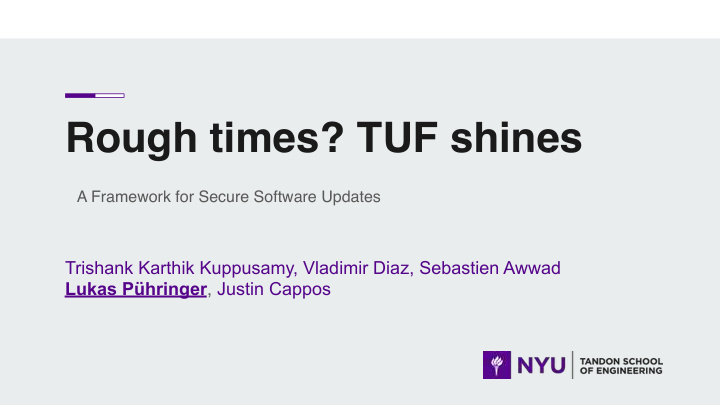



Rough times? TUF shines A Framework for Secure Software Updates Trishank Karthik Kuppusamy, Vladimir Diaz, Sebastien Awwad Lukas Pühringer , Justin Cappos
Software updates ➔ Experts agree that software updates are the most important thing to stay safe [USENIX SOUPS 2015] ➔ Updates fix security vulnerabilities ➔ However, an important problem in software updates is often neglected... 2
A compromise can have enormous impacts ➔ Nation state actors ➔ Microsoft Windows Update (2012): Flame malware targeted Iran nuclear efforts ➔ NotPetya (2017): infected multinational corporations ➔ Compromise millions of devices ➔ Worst case: human lives 3
Just sign it, … right? 4
SSL / TLS (online key) ➔ Protects users from man-in-the-middle attacks Repository User 5
The problem with SSL / TLS ➔ Doesn’t say anything about the security of the server ➔ Single point of failure: easy to compromise Attacker Repository User 6
GPG (offline key) ➔ Why not sign updates using offline GPG? ➔ Assuming usability and key distribution problem solved… ➔ Mission accomplished, right? 7
What do these organizations have in common? 8
Vulnerabilities in software updates 9
Only question is when not if a compromise happens 10
A Look in the Mirror: Attacks on Package Managers ➔ Survey of package managers [CCS 2008] ➔ Many package managers had bad security ➔ APT did better than most ➔ But still had problems! 11
Endless Data Attack Serve update until storage is full 12
Freeze Attack Trick updater into believing that there are no updates available 13
Replay Attack Serve obsolete packages that might have vulnerabilities 14
So why TUF? 15
The Update Framework ➔ Not every software updater needs an in-house solution ➔ Many years of experience in secure software updates ➔ Shields against a variety of attacks ➔ Minimizes impact of key compromise 16
Responsibility Separation Root of trust content consistency timeliness 17
Minimize individual Key and Role Risk DAMAGE ~= PROBABILITY x IMPACT High-impact role? Highly secure keys Online keys? Low-impact role 18
Multi-signature Trust (Thresholds) { "_type" : "root", "compression_algorithms": [ ... ], "consistent_snapshot":, "version" : VERSION, "expires" : EXPIRES, "keys" : { KEYID : KEY , ... }, "roles" : { ROLE : { "keyids" : [ KEYID, ... ] , "threshold" : THRESHOLD } , ... } } 19
Explicit and implicit Revocation Revocation Expiration 20
TUF Roles Overview Root Timestamp Snapshot Targets (root of trust) (timeliness) (consistency) (integrity) 21
Deployment? 22
Server (repository) ➔ Use TUF repository tools to manage keys and metadata ➔ Generate keys for each role ➔ Keep them offline ➔ Upload signed metadata + packages to Debian server 23
Client (package manager) ➔ Modify update client to use TUF client updater (just ship out with root metadata) ➔ Automatically & transparently download & verify packages ➔ Users won’t see difference ➔ Except when attacks occur 24
Conclusions ➔ Works with existing software updater ➔ Prevents from a variety of attacks (arbitrary software, endless data, extraneous dependencies, fast-forward, freeze, mix-and- match, rollback, slow retrieval, wrong software) ➔ Key compromise-resilient ➔ No out-of-band PKI or web of trust required ➔ Spin-offs and adoptions already exist 25
Deployments & Integrations 26
Thank You! Questions? https://theupdateframework.github.io/ jcappos@nyu.edu 27
Recommend
More recommend